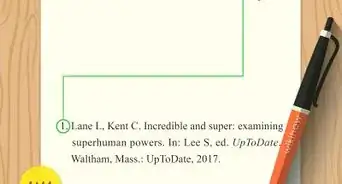This article was co-authored by wikiHow staff writer, Jennifer Mueller, JD. Jennifer Mueller is an in-house legal expert at wikiHow. Jennifer reviews, fact-checks, and evaluates wikiHow's legal content to ensure thoroughness and accuracy. She received her JD from Indiana University Maurer School of Law in 2006.
This article has been viewed 30,012 times.
Learn more...
Even if you're not in the legal field, you may want to use a court case as a source in your research paper. Law students and legal professionals use the Bluebook method of legal citation. If you're using Chicago style, follow the Bluebook format to cite a case. However, citation format differs slightly with Modern Language Association (MLA) or American Psychological Association (APA) style.
Steps
Bluebook
-
1Type the name of the case in italics. Locate the full case name in the heading of the case. Use the names of the parties, separated by the abbreviation "v." Abbreviate terms using the abbreviations found in Table 6 of the Bluebook. Place a comma at the end of the case name.[1]
- Example: Brown v. Board of Educ.,
-
2Provide court reporter publication information. Type the volume number, then a space, then the reporter abbreviation. There are no spaces in reporter abbreviations. Type a space after the reporter abbreviation, then type the first page number for the case.[2]
- Example: Brown v. Board of Educ., 347 U.S. 483
- If you quoted or paraphrased a specific part of the court's opinion, provide a pinpoint citation after the first page. For example: Brown v. Board of Educ., 347 U.S. 483, 485
Advertisement -
3Include the name of the court and the year the case was decided. Type a space after the page number, then the year the case was decided in parentheses. If the name of the court isn't evident from the reporter, type the name of the court before the year. [3]
- Example: Am. Geophysical Union v. Texaco, Inc., 60 F.3d 913, 915 (2d. Cir. 1994)
- Omit the name of the court only for Supreme Court cases. For example: Brown v. Board of Educ., 347 U.S. 483 (1954)
-
4Use a short form if you cited the case within the previous 5 footnotes. Type the name of the first party to the case, then a comma, then a space. Type the volume and reporter abbreviation, then type the word "at" followed by the page number you want to cite.[4]
- Example: Brown v. Board of Educ., 347 U.S. at 487.
- If you cited the case in the immediately preceding note, type the abbreviation "Id." in italics, then type a space. Type the word "at" followed by the page you want to cite (if it differs from the page you cited in the preceding note).
Did You Know?: In Bluebook and Chicago styles, cases are only cited in footnotes, not in a bibliography or reference list at the end of your paper.
MLA
-
1List the name of the court as the author. Although a court opinion may be written by a single justice, it is written on behalf of the majority and becomes the opinion of the whole court. The specific court is the author in an MLA Works Cited entry. Follow the name of the court with a period.[5]
- Example: United States Supreme Court.
-
2Type the name of the case in italics. Type the name of the first party to the case, then the abbreviation "v." followed by the name of the other party. Do not capitalize the abbreviation "v." Place a period at the end of the case name.[6]
- Example: United States Supreme Court. Brown v. Board of Education.
-
3Provide the date the case was decided. Only the year is required for a proper citation. However, include the day and month, if known, using day-month-year format. Place a period after the date.[7]
- Example: United States Supreme Court. Brown v. Board of Education. 17 May 1954.
-
4Add website information and a URL. If you accessed the case online, type the website's name in italics, followed by a comma. After the comma, type the name of the organization that publishes the website. Place another comma, then provide a direct URL or permalink for the case, omitting the "http://" portion of the address. Place a period at the end of the URL.[8]
- Example: United States Supreme Court. Brown v. Board of Education. 17 May 1954. Legal Information Institute, Cornell University Law School, www.law.cornell.edu/supremecourt/text/347/483.
Tip: MLA style requires you to document the specific version you consulted as a reference, not the official legal version.
-
5Include the name of the court in in-text citations. At the end of a sentence quoting or paraphrasing the court case, place a parenthetical citation with the full name of the court and the page number (if available). Place a period outside the closing parentheses.[9]
- Example: (United States Supreme Court 485).
APA
-
1Use the name of the case instead of an author. An APA reference typically lists the author's name first. However, for court cases, it isn't necessary to list the name of the judge or justice who wrote the opinion. Instead, type the name of the case in "Plaintiff v. Defendant" format. Place a comma after the case name.[10]
- Example: Brown v. Board of Educ.,
- APA style uses the Bluebook abbreviations for words in case titles.
-
2Identify the court reporter where the case was published. The reporter is listed in the heading for the case. Type the volume number, then the reporter abbreviation, then the first page number for the case. Use the abbreviations for court reporters found in the Bluebook.[11]
- Example: Brown v. Board of Educ., 347 U.S. 483
- Some cases aren't published in court reporters, and may only be available in periodicals, electronic databases, or on the internet. If you're citing one of these cases, provide publication information using the format that matches the resource.
-
3List the court and the year the case was decided. Type a space after the page number, then provide the appropriate abbreviation for the court that decided the case and the year the case was decided.[12]
- Example: Am. Geophysical Union v. Texaco, Inc., 60 F.3d 913 (2d. Cir. 1994)
- Do not include the court name if the court is the highest court in its jurisdiction, such as the U.S. Supreme Court or the highest court of a state. For example: Brown v. Board of Educ., 347 U.S. 483 (1954)
-
4Include the case name and year for in-text citations. For parenthetical citations in text, type the full case name in italics. Place a comma after the case name, then provide the year the case was decided. Place a period outside the closing parentheses.[13]
- Example: (Brown v. Board of Educ., 1954).
- If you include the case name in your text, add the year of decision in parentheses immediately after the case name.
- While the name of the case is not italicized in the reference list, it is italicized if you include it in the body of your paper, whether in text or in a parenthetical citation.
Community Q&A
-
QuestionWhat does the term "supra" mean?It means 'above', as in one level higher. For example: a supranational decision. It is a decision taken not on the level of one country, but a level higher, in a meeting between countries. If there is a risk of some island volcanoes in the Atlantic causing a tsunami to hit the east coast of the America's, then Canada, the US and Mexico would need to take supranational decisions on how to prepare for this. It can also appear in legal or educational texts to indicate something or someone mentioned earlier in the work.
Warnings
- This article covers the citation of US court cases. If you use a court case from another country as a source, refer to the legal citation rules for that country. Your instructor or a research librarian can help you.⧼thumbs_response⧽
References
- ↑ http://guides.ll.georgetown.edu/bluebook/citing-cases
- ↑ http://guides.ll.georgetown.edu/bluebook/citing-cases
- ↑ http://guides.ll.georgetown.edu/bluebook/citing-cases
- ↑ https://guides.library.harvard.edu/LLM-Bluebook
- ↑ https://style.mla.org/documenting-legal-works/
- ↑ https://style.mla.org/documenting-legal-works/
- ↑ https://style.mla.org/documenting-legal-works/
- ↑ https://style.mla.org/documenting-legal-works/
- ↑ https://owl.purdue.edu/owl/research_and_citation/mla_style/mla_formatting_and_style_guide/mla_in_text_citations_the_basics.html
- ↑ http://blog.apastyle.org/apastyle/2013/10/citing-court-decisions-in-apa-style.html
- ↑ http://blog.apastyle.org/apastyle/2013/10/citing-court-decisions-in-apa-style.html
- ↑ http://blog.apastyle.org/apastyle/2013/10/citing-court-decisions-in-apa-style.html
- ↑ http://blog.apastyle.org/apastyle/2013/10/citing-court-decisions-in-apa-style.html
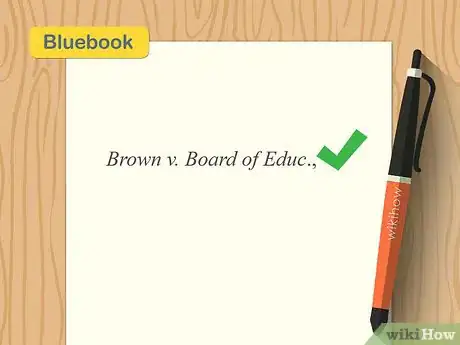
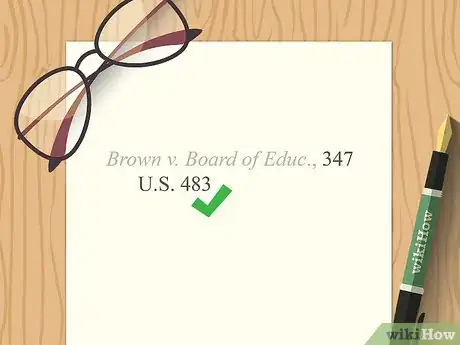

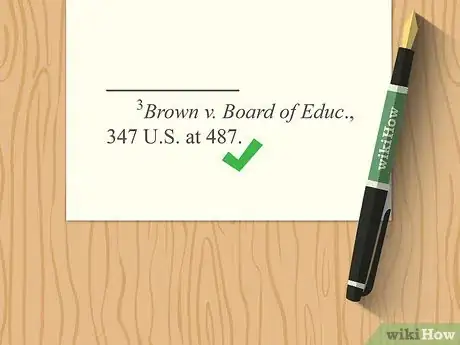
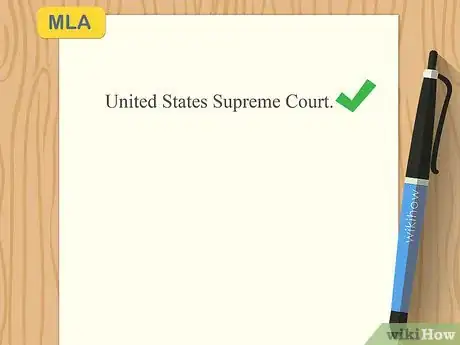
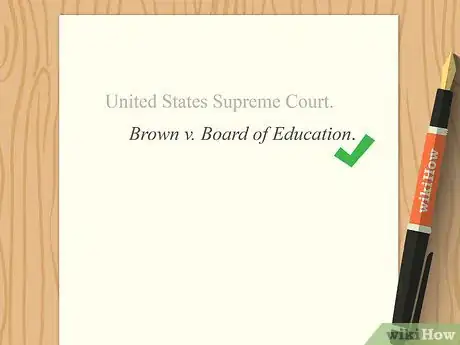
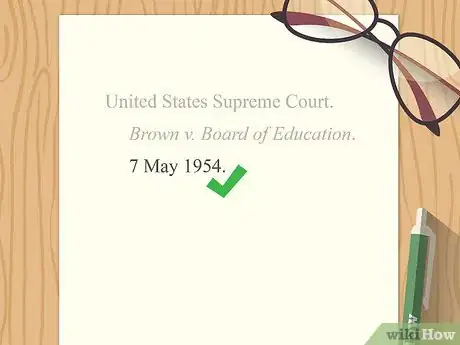
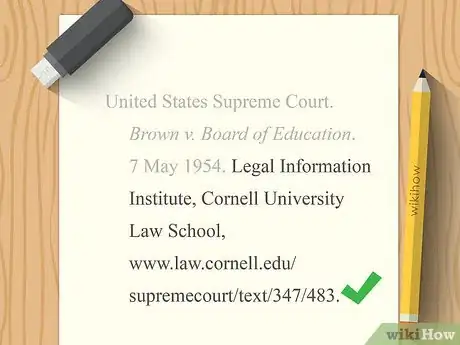

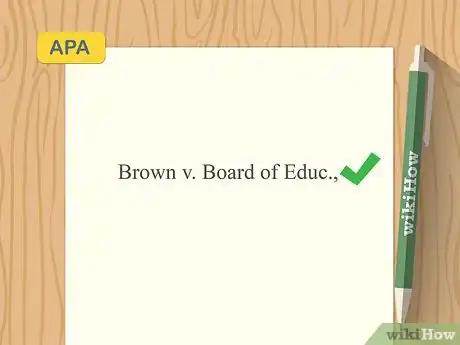

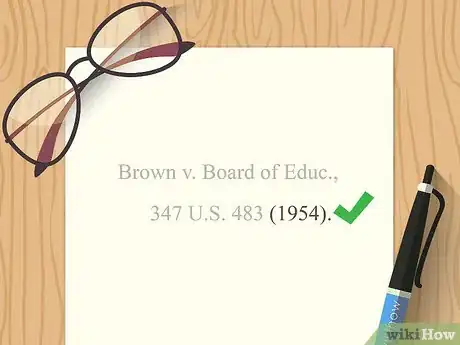
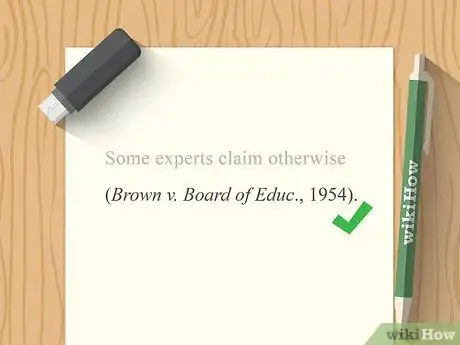

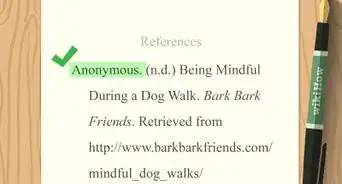









-Step-18.webp)


